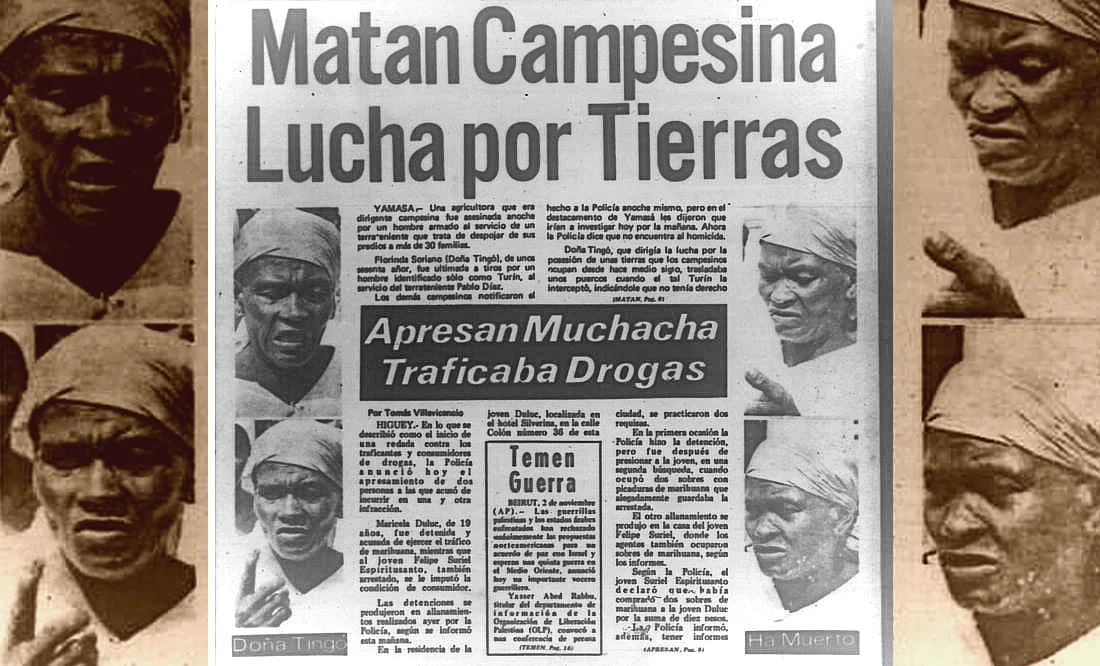Mamá Tingó (1921 - 1974)
Mamá Tingó was an activist and defender of farmers' rights in the Dominican Republic. She was born Florinda Soriano on November 8, 1914, and was assassinated on November 3, 1974, by a man named Ernesto Díaz (Turín).
She was born in Villa Mella, a municipality in Santo Domingo Norte, to a family of poor farmers. Her father's name was Eusebio Aquino Soriano. Orphaned at five years of age, Florinda was taken in by her grandmother. "As a child, she worked with her grandmother and brothers selling coal through the streets of Santo Domingo. She frequently traveled to Sabana Grande de Hato Viejo to see her older sister Margarita Chalas, married to Florencio Muñoz, brother of Felipe Muñoz, who she eventually married,"
Throughout her childhood, Florinda had no access to schooling and grew up without any formal education. She married Felipe Muñoz as a young teenager in the 1930s, giving birth to ten children, of which only seven survived to adulthood.
Together with her husband and children, Florinda worked a small plot of land that was handed down by her father-in-law. They earned a living by raising pigs for meat, farming fruits and vegetables and collecting firewood to sell in the city of Santo Domingo.
When her husband Felipe died (date unknown), Mamá Tingó continued to work the land together with her children. She later re-married to a man named Jesús María de Paula.
The Assassination of Mamá Tingó
In early 1974, a wealthy landowner named Pablo Díaz Hernández, claimed the land that Mamá Tingó and the surrounding farmers of Hato Viejo had worked and lived on for more than half a century. Supported by agents of the National Police, Díaz Hernández evicted the farmers and fenced around eight thousand tareas (about 1200 acres).
Together with the Federation of Christian Agricultural Leagues (FEDELAC), Mamá Tingó led the struggle of the local farmers in defense of the lands they considered their own. She actively encouraged community mobilization in defense of more equitable distribution of land in Dominican Republic.
On November 1, 1974, the land dispute made it to the Monte Plata tribunal. Led by Mamá Tingó, many farmers attended the hearing to have their voices heard. But the case was postponed due a non-appearance by the professed landowner Pablo Díaz Hernández.
According to the story told by her relatives and neighbors, Mamá Tingó returned to her farm after the trail and was alerted that her pigs had been cut loose by Ernesto Díaz (Turín), a foreman of Pablo Díaz Hernández. Mamá Tingó immediately set out to round up her pigs, and was eventually confronted by Ernesto Díaz, who insisted that she had no right to be there. The confrontation escalated and Ernesto Díaz shot Mamá Tingó with a shotgun. The first shot wounded her in the head, and according to the story, Mamá Tingó tried to defend herself with a machete. However, with the second shot, Mamá Tingó's chest was shattered, ending her life.
In a newspaper clipping (pictured above); neighbors reported the crime to the local police that same night, but were told that the situation would not be handled until the next day.
Recounting the events after the assassination of her mother, Bonifacia Muñoz, states that when the authorities arrived they proceeded to arrest members of her family.“They have us as we are dogs, like if we are not people. That they do things to us, they kill our family, and then they arrest us.”
Mamá Tingó's assassin was eventually arrested, but was released on bail several months later.
Contributions, legacy, and honors
Today, Mamá Tingó is a revered symbol of the fight against injustice and the exploitation of the poor by the rich in the Dominican Republic. Her memory is honored every November in remembrance of her birth and death. Artists have continued her legacy with sculptures, drawings and paintings. Local governments have honored her story with memorials, and activists today continue to push the idea that embodied Florinda Soriano, remembered as Mamá Tingó.
A Note On Accuracy:
While researching for this article I came across several articles with different information regarding the story of Mamá Tingó. One such information that may conflict is the encounter of Mamá Tingó with her assassin Ernesto Díaz (Turín). Although all sources share the same narrative that Turin did kill her; some sources claim that Turin "ambushed" Mamá Tingó. Ambushed may resonate more with an assassination than confronted. However, in the newspaper clipping it is stated that Turin exchanged words with the victim before shooting. For this reason I chose to use the word confronted.
Some discrepancy may exist with dating; such as Florinda Soriano's birthdate. Some sources claim that she was born in 1921, while others claim 1914. For this I again turn to the newspaper clipping which states that Florinda was around sixty years old at the time of her death.
In the newspaper clipping Florinda is referred to as "Doña Tingo." I chose to continue the use of Mamá Tingó for the purpose of the preservation of the symbol that has become Mamá Tingó.
Some sources state that Florinda gave birth to seven children and that only five survived. For this I chose to use the information given by Fernando Valerio-Holguín.
Credit Where Credit Is Due
The information you have read has been gathered through online research. Sources include; educando.edu.do, listindiario.com, acento.com.do, wikipedia.org, Noticias SIN (YouTube and Facebook). "La triple marginalidad: Florinda Soriano (Mamá Tingó)" by Fernando Valerio-Holguín.

